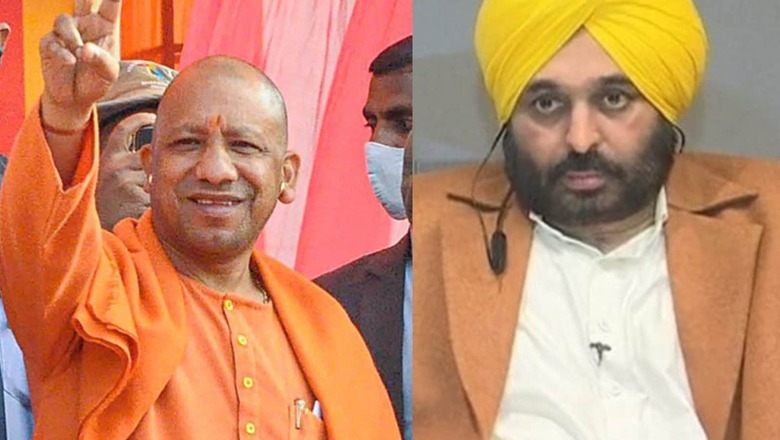
views
Since the AAP government has come into power in Punjab, top headlines from the state have been dominated by news of murders, extortions and protests gone violent. While the murder of singer Sidhu Singh Moose Wala this week has sent shock waves in the entire country but people on the ground know that it was not the only high-profile murder in the state in recent times. Whether it was the targeted killings of international Kabaddi players, the murder of a Congress leader and ex-Gram Sarpanch in Sangrur or the cold-blooded killing of kin of a famous Punjabi film star, Punjab has witnessed multiple instances of violence against well-connected and powerful people. One can only imagine what the common people must be facing in the state.
A question that many are asking is what’s plaguing Punjab’s law and order situation? The answer lies in its thriving Gangster culture and political patronage of the same. Punjab has more than 11 notorious gangster groups whose network extends from Rajasthan to UP with some of their key operatives even based in foreign countries such as Canada. Such is their notoriety internationally that the Canadian-Punjabi Gangster network is ranked third behind Italian-Canadian Mafia and Asian organised Triad crime collectives in Canada.
Such is their notoriety internationally that the Canadian-Punjabi Gangster network is ranked third behind Italian-Canadian Mafia and Asian organised Triad crime collectives in Canada.
Also Read: Cracking the Whip on Mafia, Goondas, Yogi Gave UP What It Always Wanted — Sense of Security
The popular culture in Punjab especially in the post-militancy and post-liberalisation era can be blamed without any doubt for the glorification of this gangster culture in the state. These gangsters have a huge social media following where they flaunt their high-ended lifestyle full of SUVs and guns. Interestingly, after Sidhu Moose Wala’s killing, they were busy competing with each other to take responsibility for his murder on social media to gain more following. On multiple occasions, they have killed fellow gangsters even while they were in police custody. One of them even planned to kill Salman Khan while he was in town for a film shoot. They thrive on their political connections and do rent-seeking from the rich and famous for a living.
Things get even murkier when their links with inimical cross-border forces are scrutinised. These gangster networks enjoy tacit support from Pakistan’s ISI which is emboldening them to disturb law and order in Punjab, a key border state. Harvinder Singh Rinda, a gangster who ran away to Pakistan is now allegedly controlling the gangster network in order to foment anti-India activities in the name of “Khalistan”. Reportedly, the main conspirator of a grenade attack on Police Intelligence Headquarters in Mohali, Lakhbir Singh Landa was a Punjab-based gangster before he ran away to Canada and joined ISI-backed Babbar Khalsa.
Also Read: Punjab Police Leaking PM’s Travel Plan Isn’t a Security Lapse, It is Dirty Politics
In Punjab, the nexus between politicians and gangsters is very strong with leaders across the political spectrum patronising them to wield muscle power on their behalf. This was on display in 2019 in full glory when a Shiromani Akali Dal leader Dalbir Singh Dhilwan was shot dead and main accused Jaggu Bhagnwapuria’s links with Congress and Akali Dal surfaced. This nexus can be traced back to the militancy days of Punjab. But the active participation of gangsters in electoral politics continues even today. Mafia of all kinds including drug and sand mafias run amok in Punjab with deep support from politicians. What’s worse is that they canvass for votes in elections, draw crowds at rallies and even participate in student elections in universities of Punjab.
On one hand, we have Punjab which is on the verge of becoming a national security issue all over again. On the other, there is the example of Uttar Pradesh where CM Yogi Adityanath returned to a thumping victory on the back of a successful record on law & order.
Punjab can learn a lot from the UP Model of law and order. UP also had a thriving gangster culture with open support from politicians but the Yogi government’s intervention has turned around the state’s law and order situation. In his first tenure, CM Yogi Adityanath earned the sobriquet of “Bulldozer Baba” because of his policy of demolishing properties of gangsters in order to set an example and deter other criminals from following suit. He didn’t even spare political bigwigs such as Azam Khan from his policy who was lodged in jail and his property was “bulldozed”. Around ₹1500 crore worth of property was seized from criminals and gangsters in the first four years of his term during which housing projects for the poor were launched by the UP government. By the end of his tenure, 139 criminals were killed and 3196 were injured in encounters with the UP police. Record 13,700 cases were registered and 43000 people were arrested under the Gangster Act.
In his second term, Yogi’s resolve has got even stronger with his new policy of every police station in the state cracking down mandatorily on 10 top criminals in their jurisdiction every month. UP has a total of 1536 thanas and in this way every month, action against 15360 criminals will be taken in the state. UP’s famous Gangster Act which was originally conceived in the 80s by a Congress government has been controversial but it has also helped in cracking down on Gangsters in the state. Punjab doesn’t even have a similar act in place. An Organised Crimes Act along the lines of the Maharashtra Organised Crimes Act (MCOCA) was discussed many a time but it was always put into cold storage over the fear of being used for political vendetta. Senior officials in the Police establishment have time and again flagged the need for such an act. The conviction rate of gangsters under the present act is just 1-5% with many ‘A’ category gangs still active in the state. Hence, they point out how the police need to be empowered so that gangsters can be reined in.
The crackdown on the gangster-politician nexus and eradication of gangster culture requires political will and wherewithal to improve law and order. However, the AAP government’s policy of playing politics and taking U-turns isn’t helping much. A glaring example of the same is Arvind Kejriwal’s promise that AAP will end the transport mafia in the state if elected to power. But after elections, his own MLA Amalok Singh was involved in violence over control of truck unions where 30 people were seriously injured. Not to mention, Mohali Police’s crazy witch-hunt over a mere tweet of BJP spokesperson Tajinder Pal Singh Bagga while their own intelligence headquarters faced a grenade attack just miles away from the high-security zone of state capital Chandigarh. CM
Bhagwant Mann has also not shown the same maturity and seriousness as displayed by Yogi in eradicating crime from UP. One of the first of his priorities was to tour Himachal Pradesh and Gujarat to improve AAP’s electoral fortunes after becoming the CM. AAP’s official handle was publicising the removal of Moose Wala’s security on Twitter and the very next day he was shot dead. AAP must realise that Punjab is not Delhi where a large public relations & media budget can compensate for action on the ground. Its record of blaming the centre will not work in a key border state. Instead of looking for cheap political thrills, Mann must get down to the whiteboard and draw a serious plan to ramp up Punjab’s security.
The author is a PhD in International Relations from the Department of International Relations, South Asian University. Views expressed in this article are those of the author and do not represent the stand of this publication.
Read all the Latest Opinions here


















Comments
0 comment